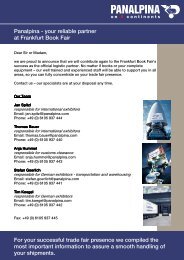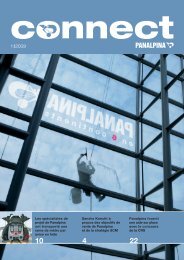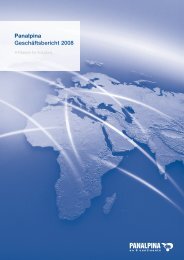Panalpina Annual Report 2006
Panalpina Annual Report 2006
Panalpina Annual Report 2006
Create successful ePaper yourself
Turn your PDF publications into a flip-book with our unique Google optimized e-Paper software.
Consolidated and <strong>Annual</strong> Financial Statements <strong>2006</strong><br />
Normally, the Group consciously decides not to designate derivative instruments for hedge accounting according to<br />
IAS 39 (although they all are hedging-instruments from an economic point of view). Otherwise, the Group can designate<br />
individual derivatives as either:<br />
• a hedge of the exposure to changes in the fair value of a recognized asset or liability (fair value hedge),<br />
• a hedge of the exposure to variability in cash flows associated with a recognized asset or liability or a highly probable<br />
forecast transaction (cash flow hedges) or<br />
• a hedge of net investments in a foreign operation.<br />
For qualifying cash flow hedges, the derivative hedging instrument is recorded at fair value. The portion of any change in fair<br />
value that is an effective hedge is included in equity, and any remaining ineffective portion is reported in income (expense).<br />
If a hedged forecast transaction results in the recognition of a non-financial asset or liability, the cumulative change in fair<br />
value of the hedging instrument that has been recorded in equity is included in the initial carrying value of that asset<br />
or liability at the time it is recognized. For all other qualifying cash flow hedges, the cumulative changes in fair value of the<br />
hedging instrument that have been recorded in equity are included in income (expense) at the time when the forecasted<br />
transaction affects net income.<br />
For qualifying hedges of net investments in foreign operations, the hedging instruments are accounted in a manner similar<br />
to cash flow hedges. The foreign exchange portion of any change in fair value that is an effective hedge is included in<br />
equity as translation reserve. Any remaining ineffective portion is recorded in income (expense). If the hedged subsidiary is<br />
disposed of, then the cumulative amounts that have been recorded in equity are included in income (expense) at the time<br />
of the disposal.<br />
4 Critical accounting estimates and judgments<br />
Estimates and judgments are continually evaluated and are based on historical experience and other factors, including<br />
expectations of future events that are believed to be reasonable under the circumstances.<br />
Critical accounting estimates and assumptions<br />
The Group makes estimates and assumptions concerning the future. The resulting accounting estimates will, by definition,<br />
seldom equal the related actual results. The estimations and assumptions that have a significant risk of causing a material<br />
adjustment to the carrying amount of assets and liabilities within the next financial year are discussed below.<br />
Estimated impairment of goodwill<br />
The Group tests annually whether goodwill has suffered any impairment, in accordance with the accounting policy stated in<br />
the note Intangible assets, section Goodwill. The recoverable amounts of cash-generating units (CGU) have been determined<br />
based on value-in-use calculations. These calculations require the use of estimates.<br />
A sensitivity analysis shows that a reduction of free cash flow of the tested CGU of up to 10% at most would not result in an<br />
impairment of goodwill.<br />
Claim provisions<br />
A number of subsidiaries are subject to litigation arising out of the normal conduct of their businesses, as a result of which<br />
claims could be raised against them.<br />
The Group used for the above mentioned provision the conservative actuarial calculation, which requires for the calculation<br />
of the “incurred but not reported reserves (IBNR)”, among other estimations, the overall circumstances which may impact<br />
the future losses, such as the growth of business. If the management decided to use the optimum actuarial calculation<br />
method, which takes only into consideration the linear loss development according to historical figures, the carrying amount<br />
of claim provision would be approximately CHF 2.7 million lower. If the used actuarial calculation would differ by 10%<br />
from the management’s estimates, the carrying amount of claim provision would be approximately CHF 1.8 million higher.<br />
Income taxes<br />
The Group is subject to income taxes in numerous jurisdictions. Significant judgments are required in determining the current<br />
and deferred assets and liabilities for income taxes. Some of these estimates are based on interpretations of existing<br />
tax laws or regulations. Management believes that the estimates are reasonable and that the recognized liabilities for income<br />
tax related uncertainties are adequate. Various internal and external factors may have favorable or unfavorable effects on<br />
the income tax assets. These factors include, but are not limited to, changes in tax laws regulations and / or rates, changing<br />
interpretation of existing tax laws or regulations and changes on management estimations. Such changes that arise could<br />
affect the assets and liabilities recognized in the balance sheet in future periods.<br />
<strong>Panalpina</strong> <strong>Annual</strong> <strong>Report</strong> <strong>2006</strong> 87



![Eigenes Luftfrachtnetzwerk [pdf | 244 KB] - Panalpina](https://img.yumpu.com/23347328/1/184x260/eigenes-luftfrachtnetzwerk-pdf-244-kb-panalpina.jpg?quality=85)
![Übersicht Panalpina [pdf | 240 KB]](https://img.yumpu.com/22547731/1/184x260/ubersicht-panalpina-pdf-240-kb.jpg?quality=85)

![Seefracht [pdf | 181 KB] - Panalpina](https://img.yumpu.com/22234724/1/184x260/seefracht-pdf-181-kb-panalpina.jpg?quality=85)
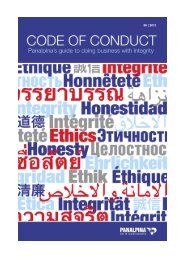
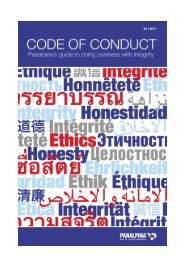

![Annual Report 2012 [pdf | 1 MB] - Panalpina](https://img.yumpu.com/15342099/1/184x260/annual-report-2012-pdf-1-mb-panalpina.jpg?quality=85)



